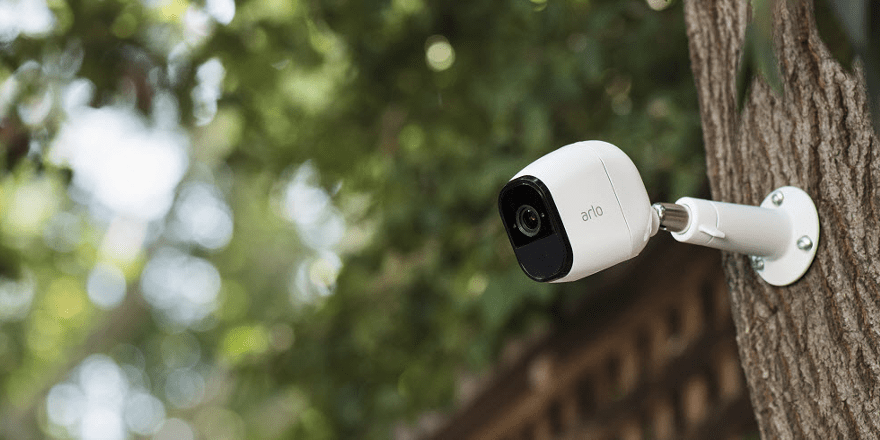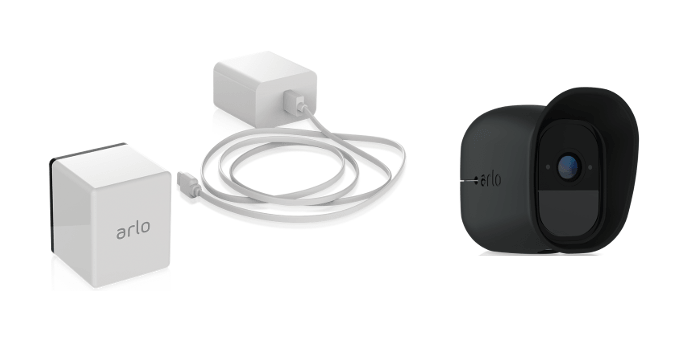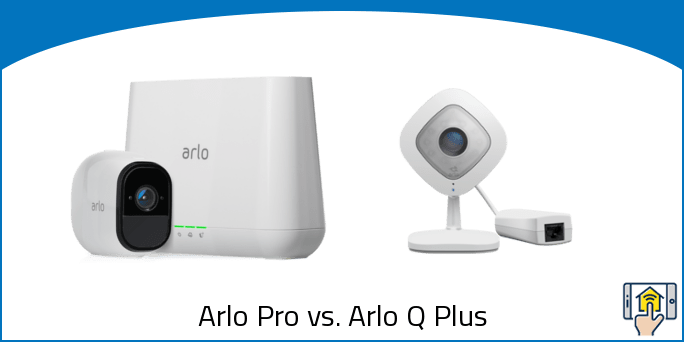When comparing the Arlo Pro vs. Arlo Q Plus, it’s clear that there are things to like about both models. However, we feel that the Arlo Q Plus is the superior choice for indoors.
The Arlo Pro is missing some useful features — a lot of which have been added in with the improved Arlo Pro 2. With that said, it does have weatherproofing which makes it a better option than the Q Plus if you’re looking for outdoor monitoring.
Arlo Pro vs. Arlo Q Plus — Differences
-
Difference #1: Power Options – The first notable difference when comparing the Arlo Pro vs. Arlo Q Plus is the way that they are powered.
Both cameras offer the option for traditional AC power through a plug. However, they differ in their secondary option for power.
The Arlo Pro works with a rechargeable battery as well, which will give you 3-6 months of monitoring on a single charge. You can even purchase a solar panel to keep it topped off and never worry about charging again!
The Arlo Q Plus, on the other hand, supports Power over Ethernet, which allows you to provide internet access and power through a single cord. For more information on the benefits that PoE has to offer, check out our article: What Is Power Over Ethernet?
-
Difference #2: Internet – There are two main frequencies that modern WiFi routers work with, 2.4GHz and 5GHz. The Arlo Pro is a single band device, so it only transmits data over the 2.4GHz frequency — potentially leading to network congestion.
The Arlo Q Plus supports both 2.4GHz and 5GHz, and there are a couple of ways you can access that.
The dual band feature is enabled with WiFi by default. For Ethernet, you can either use the small adapter to use AC power and a hard wired internet connection, or you can provide both power and internet access through the Ethernet cord using PoE. Just make sure you have the PoE switch, since PoE and regular Ethernet connections are two different things.
Ultimately, the Arlo Q Plus does a better job at reducing the load on your network, and gives you an option for a more stable and reliable connection with its support for Ethernet and PoE.
-
Difference #3: 24/7 Recording – For areas where you want some extra security, it’s nice to have the option for Continuous Video Recording (CVR).
The Arlo Q Plus offers CVR for an additional fee, charged on a per-camera basis.
For 14 days of rolling storage, the price is $9.99 per month, with 30 days of storage available for $19.99 per month.
For that price, it isn’t feasible for most of us to add in CVR on multiple cameras. It’s a great perk to have available for areas where you want consistent footage, however, such as your main camera near the entryway.
Unfortunately, CVR is not supported on the Arlo Pro.
-
Difference #4: Video Quality – Another area where the Arlo Q Plus pulls ahead is in its video quality. The camera records in 1080p HD with a 130° field of view, while the Arlo Pro is only capable of 1280 x 720p and a 110° field of view respectively.
However, when it comes to frames per second, both cameras record at 30 FPS, so whichever action takes place it won’t be blurry. The cameras also feature H.264 compression to reduce the load on your network.
So, after all video quality is one of the major differences between the Arlo Pro vs. Arlo Q Plus. It’s clear that the Arlo Q Plus is the better option in this case due to the higher resolution and wider field of view. In addition to footage that just looks a lot better, it can also make all the difference when trying to identify intruders amidst the chaos of a home invasion.
-
Difference #5: Motion Detection – While both cameras do have motion zones, it would be disingenuous to say that they’re the same. The Arlo Pro has a range of up to 23 feet, and doesn’t have any built-in motion zones — relying on the Arlo Smart Add-On In order to access the cloud activity zones.
The Arlo Q Plus has a far longer range of 50 feet, and has access to 3 activity zones by default.
Long story short, the Q Plus is clearly better when it comes to motion detection.
-
Difference #6: Requires a Base Station – One aspect that ties cameras like the Arlo, Arlo Pro, and Arlo Pro 2 together is their reliance on a base station. This is an extra piece of equipment you’ll have to connect to your router in order to allow your cameras to work correctly.
With the base station plugged in via Ethernet, your Arlo Pro will have a longer range for its WiFi and a better battery life. It also enables features like a built-in siren, which we’ll talk about below.
Up to 15 cameras can connect to a single base station, and will work with either the original station or the Pro model. Check out our comparison of the Arlo vs. Arlo Pro Base Station for a better understanding of the differences.
The Arlo Q Plus ditches the base station. It’s great to be able to cut out the middleman and free up some space around your router, but you do lose access to perks like an increased range and the siren.
-
Difference #7: Siren – Since the Arlo Pro relies on a base station in order to connect to the internet, it also has access to a siren that you can activate in an emergency to alert your family and neighbors and scare off intruders.
The simplicity of the Arlo Q Plus is great, but you do end up missing out on the siren.
-
Difference #8: Local Backup Storage – Both cameras offer an option for local backup storage, but they differ in the way that it works.
The Arlo Pro uses a USB drive plugged into the base station in order to backup footage, and will alert you when it’s full and even record over the older footage so that you don’t have to worry about swapping it out.
Since the Arlo Q doesn’t have a base station, it backs up footage to a microSD card with a capacity of up to 128GB.
One thing to keep in mind with the local storage on both cameras, however, is that you can’t use them as your primary way to keep recordings — you’ll still have to use the cloud. However, having the USB or microSD there as a backup in the case that your internet goes down can definitely help avoid data loss in the event that your internet goes down.
-
Difference #9: Weather-resistant – One difference that really separates these two models is the fact that the Arlo Pro is weather resistant with IP65 rating in a range of -4° to 113° F, while the Arlo Q Plus is designed for indoors only.
The Q Plus is a superior camera to the Pro in many ways, but if you’re looking for outdoor monitoring, your choice has pretty much already been made for you.
Arlo Pro vs. Arlo Q Plus — Comparison Chart
| Arlo Pro | Arlo Q Plus | |
|---|---|---|
| Video resolution | 1280 x 720p | 1080p HD |
| Frames per Second | 30 FPS | 30 FPS |
| Video Format | H.264 | H.264 |
| On-Demand Live View | Yes | Yes |
| Record Live View | Yes | Yes |
| Field of View | 110° | 130° |
| Zoom | 8x digital zoom | 8x digital zoom |
| Power | Rechargeable Battery/AC | AC or PoE |
| Optional Power Source | Solar Panel | PoE |
| Battery Life | Battery: 3-6 months Solar: indefinitely |
N/A |
| Two-Way Audio | Yes | Yes |
| Motion Detection | Up to 23 feet | Up to 50 feet |
| Motion Zones | No (available w/ subscription) | Up to 3 activity zones |
| Person Detection | With Subscription | With Subscription |
| Facial Recognition | No | No |
| Sound Detection | Yes | Yes |
| Night Vision | 850 nm LEDs: illuminates up to 25 feet IR cut-off filter |
850 nm LEDs: illuminates up to 25 feet IR cut-off filter |
| WiFi | 2.4GHz | 2.4 & 5GHz |
| Requires a Base Station | Yes | No |
| Max # of Cameras per Base Station | 15 | – |
| Siren | Via the Base | No |
| 24/7 Recording | No | Optional |
| Local Backup Storage | Via the Base | Yes |
| Cloud Storage | 7-Day Free / Subscription | 7-Day Free / Subscription |
| Review, Share, & Save | Yes | Yes |
| e911 Emergency Call | With Subscription | With Subscription |
| Instant App Alerts | Yes | Yes |
| App Support | Android, iOS, Web | Android, iOS, Web |
| Rich Notifications | With Subscription | With Subscription |
| Weather-resistant | IP65 rating | No |
| Amazon Alexa | Echo Show, Echo Spot | Echo Show, Echo Spot |
| Google Assistant | Yes | Yes |
| IFTTT | Yes | Yes |
| Stringify | Yes | Yes |
| Operating Temperature | -4° to 113° F | Indoors |
| Dimension | 3.1 x 1.9 x 2.8 in | 2.75 x 2.80 x 4.50 in |
| Color | White | White |
Arlo Pro vs. Arlo Q Plus — Things in Common

-
Live View – Keeping an eye on your home is simple from wherever you are, with the ability to view and record your view feed at any time through the Arlo App.
-
Zoom – in the event of an emergency, it’s important that you’re able to get a clear picture of the details. A big part of this is the quality of the video feed, but the 8x digital zoom on the Arlo Pro and Arlo Q Plus allows you to keep the action in the frame to collect valuable evidence.
-
Two-Way Audio – These cameras make it easy to keep your pets off the furniture or scare off thieves with support for two-way audio. Listen in and talk back through the Arlo App or through compatible smart devices.
-
Motion & Sound Detection – The smart feature that separates these types of cameras from more traditional security solutions is their ability to activate whenever they detect activity. Both cameras can alert you when they detect motion, as well as whenever they sense sound.
-
Night Vision – Many home intrusions happen under the cover of darkness, so it’s important that your cameras be equipped with night vision to keep an eye on your house in the dark.
When it comes to night vision, there’s little to no difference between the Arlo Q Plus vs. Arlo Pro. The 850nm LEDs, 25 foot illumination range, and IR cut-off filter make these two cameras equally impressive when it comes to 24/7 video monitoring.
-
Subscription & Cloud Storage – Both cameras offer a subscription service called Arlo Smart.
By default, your cameras will come with Arlo Smart Basic — the company’s entry-level plan that provides 7 rolling days of cloud storage and support for up to 5 cameras.
If you’d like to add in more cameras and/or have access to more storage, you could sign up for the company’s Premier or Elite plans.
Arlo Smart Premier is available for $9.99/month and allows for 30 days of video storage and support for up to 10 cameras.
Arlo Smart Elite costs $14.99/month, supports 20 cameras, and 60 days of cloud storage.
These three plans are your main choices for storage and expanding your home camera setup. However, the company also offers an Arlo Smart Add-On that adds in some extra utility for your monitoring. This is available at a cost of $2.99 per camera, but the features are included free with the Premier or Elite subscriptions plans.
Arlo Smart Add-On enables cloud activity zones that allow you to adjust the sensitivity of your cameras’ motion detection in each area for more accurate alerts. The detection is also further enhanced by Person Detection that enables your Arlo cameras to do a better job of recognizing human activity.
Other security enhancements with the Arlo Smart Add-On are the Rich Notifications feature that allows you to respond to a notification with a single swipe rather than unlocking your phone and opening the app, as well as e911 Emergency Call Service that ensures the authorities will always be sent to the correct location in the event of a security emergency.
All in all, we feel Arlo’s subscription plans are pretty attractively priced. Also, they offer enough functionality to get by in their free plan which makes paying monthly completely optional.
-
App Support – In addition to the standard Android, iOS and FireOS apps, both cameras also allow you to access your cameras from any computer using your account on Arlo’s website.
-
Voice Control – Controlling your camera with voice commands makes the Arlo Pro and Arlo Q Plus feel more intelligent and convenient. Both cameras feature support for Amazon Alexa and Google Assistant, with the Alexa integration being particularly useful.
In addition to the standard voice control, you can also access your feed through devices like the Echo Show or Echo Spot. With the Echo Show, however, you won’t be able to take advantage of the two-way audio feature — you’d need a camera like the Ring Stick Up Cam for that.
-
IFTTT & Stringify – Both models support the IFTTT and Stringify trigger making platform. These tools are really useful for connecting your smart devices together for a more convenient home. They can also have some security applications as well, allowing you to do things like turn on all the lights when your camera detects activity.
Arlo Pro vs. Arlo Q Plus — Accessories

You don’t technically need anything besides the cameras themselves to get things set up. However, there are a few different accessories you might want to grab to make your life easier or more convenient.
Since the Arlo Pro gives you the option for battery power, it might be nice to have a Solar Panel on hand, as well as an extra Rechargeable Battery to keep coverage going in the event that you have to swap the main one out. For outside monitoring, the Arlo Security Light is great for illuminating your yard, while the Arlo Pro Skins can help better conceal and protect your camera.
If you were planning to use Arlo Q Plus with PoE, you can kill two birds with one stone by buying the Arlo Q Plus Camera Bundle with 8-Port Gigabit Ethernet Switch with 4-Port PoE. For a more fun and attractive look to your camera, you could also pick out your favorite from their Colorful Silicone Skins.
Arlo Pro vs. Arlo Q Plus — Our Thoughts

It’s pretty clear when comparing the Arlo Pro vs. Arlo Q Plus that the Q Plus has a lot more going for it. It’s a high quality product with multiple options for power and internet connections, as well as options like motion zones, 24/7 CVR, and PoE. The main downside is the lack of weatherproofing.
If you’re looking for a camera that is quite similar to the Arlo Q Plus but that you can use outdoor, we recommend taking a look at the gen 2 Ring Stick Up Cam Wired; with 1080p quality, impressive motion detection, PoE, and even more affordable subscription options, you won’t be disappointed!
While we do feel the Arlo Pro is great, it’s really held back by the lack of features like CVR and motion zones. However, those problems have been addressed with the Arlo Pro 2 — check out the Arlo Pro vs. Arlo Pro 2 to learn more.
[toggle title=”Related Articles”]
- What is Power Over Ethernet? | JCA
- Arlo Q vs. Arlo Q Plus | JCA
- Arlo Camera Comparison Chart & Overview | JCA
[/toggle]
Last update on 2024-04-24 at 04:21 / Affiliate links / Images from Amazon Product Advertising API




